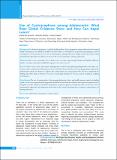Please use this identifier to cite or link to this item:
https://hdl.handle.net/20.500.14356/1457Full metadata record
| DC Field | Value | Language |
|---|---|---|
| dc.contributor.author | Shrestha, Dirgha Raj | - |
| dc.contributor.author | Bhadra, Rajendra | - |
| dc.contributor.author | Dangal, Ganesh | - |
| dc.date.accessioned | 2023-05-14T06:07:52Z | - |
| dc.date.available | 2023-05-14T06:07:52Z | - |
| dc.date.issued | 2020 | - |
| dc.identifier.citation | Shrestha D. R., BhadraR., & DangalG. (2021). Use of Contraceptives among Adolescents: What Does Global Evidence Show and How Can Nepal Learn?. Journal of Nepal Health Research Council, 18(4), 588-595. https://doi.org/10.33314/jnhrc.v18i4.3249 | en_US |
| dc.identifier.issn | Print ISSN: 1727-5482; Online ISSN: 1999-6217 | - |
| dc.identifier.uri | http://103.69.126.140:8080/handle/20.500.14356/1457 | - |
| dc.description | Review Article | en_US |
| dc.description.abstract | Abstract Background: Adolescent pregnancy is a global health problem. Early pregnancies among adolescents have major health consequences for adolescent mothers and their babies. Contraceptives can prevent early pregnancy and its consequences. However, there is a low use of contraceptives among adolescents. Global evidence has shown which programmatic approaches are effective to increase the use of contraceptives among adolescents. Methods: This is not a systematic review. Desk review was done using Google Scholar and PubMed. Different policies, strategies, and reports published by agencies were also reviewed. Results: There is a low use of contraceptives and high unmet need for family planning and high adolescent fertility rate. Various studies conducted in different parts of the world have shown that there are some programmatic approaches implemented which are effective to improve the contraceptives use among adolescents. We have categorized the findings into three parts; i) delivery of services ii) increasing demand for services, and iii) creating an enabling environment. Conclusions: The use of contraceptives is low among adolescents in low- and middle-income countries including Nepal. So, the current programmatic approaches should be reviewed and the evidence-based practices implemented to bring better results. Ministry of Health and Population and partner agencies in Nepal also need to review the current programmatic approaches and implement them based on the evidence-based practices to improve contraceptives use among adolescents. Keywords: adolescents; contraceptive; evidence-based | en_US |
| dc.language.iso | en | en_US |
| dc.publisher | Nepal Health Research Council | en_US |
| dc.relation.ispartofseries | Oct-Dec, 2020;3249 | - |
| dc.subject | Adolescents | en_US |
| dc.subject | Contraceptive | en_US |
| dc.subject | Evidence-based | en_US |
| dc.title | Use of Contraceptives among Adolescents: What Does Global Evidence Show and How Can Nepal Learn? | en_US |
| dc.type | Journal Article | en_US |
| local.journal.category | Review Article | - |
| Appears in Collections: | Vol. 18 No. 4 (2020): Vol. 18 No. 4 Issue 49 Oct-Dec 2020 | |
Files in This Item:
| File | Description | Size | Format | |
|---|---|---|---|---|
| 3249-Manuscript-19984-1-10-20210122.pdf | Fulltext Download | 251.35 kB | Adobe PDF |  View/Open |
Items in DSpace are protected by copyright, with all rights reserved, unless otherwise indicated.
